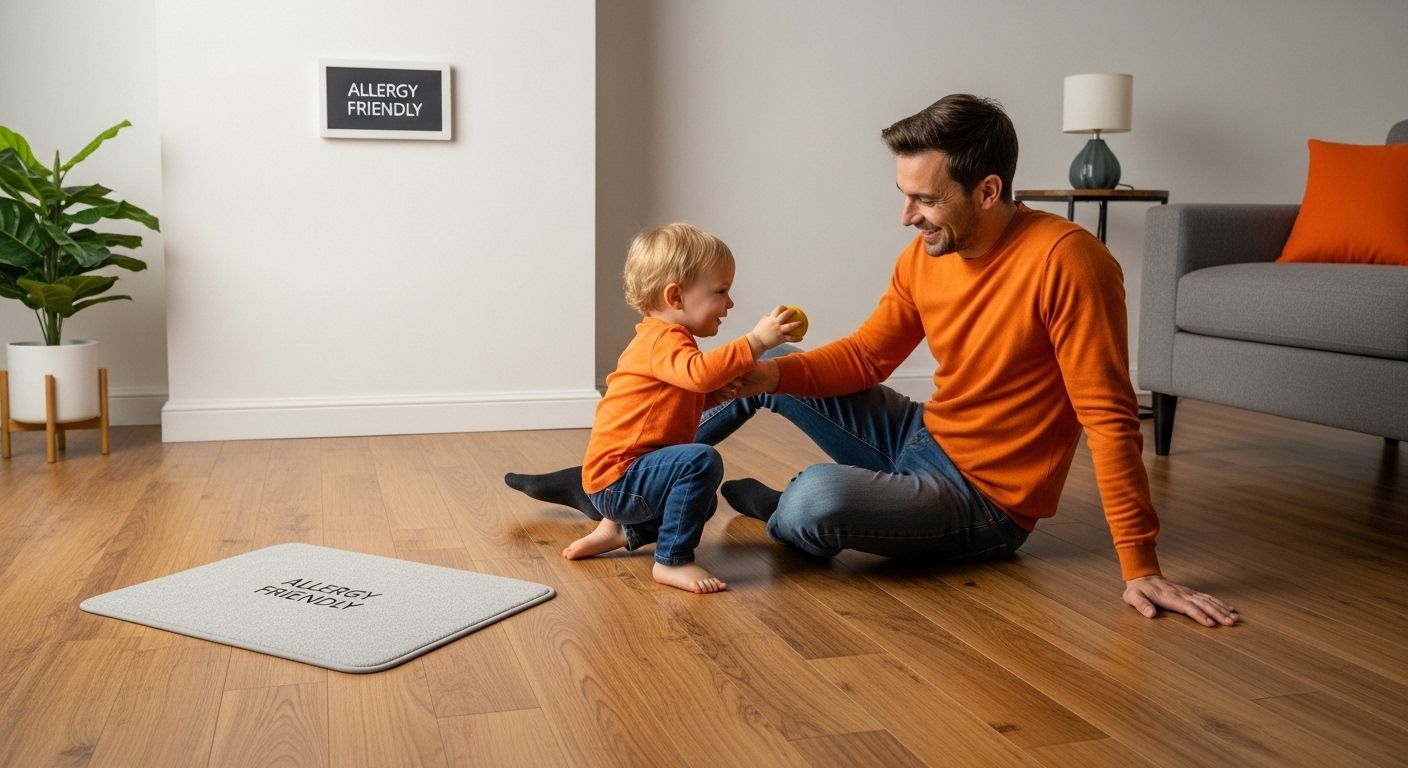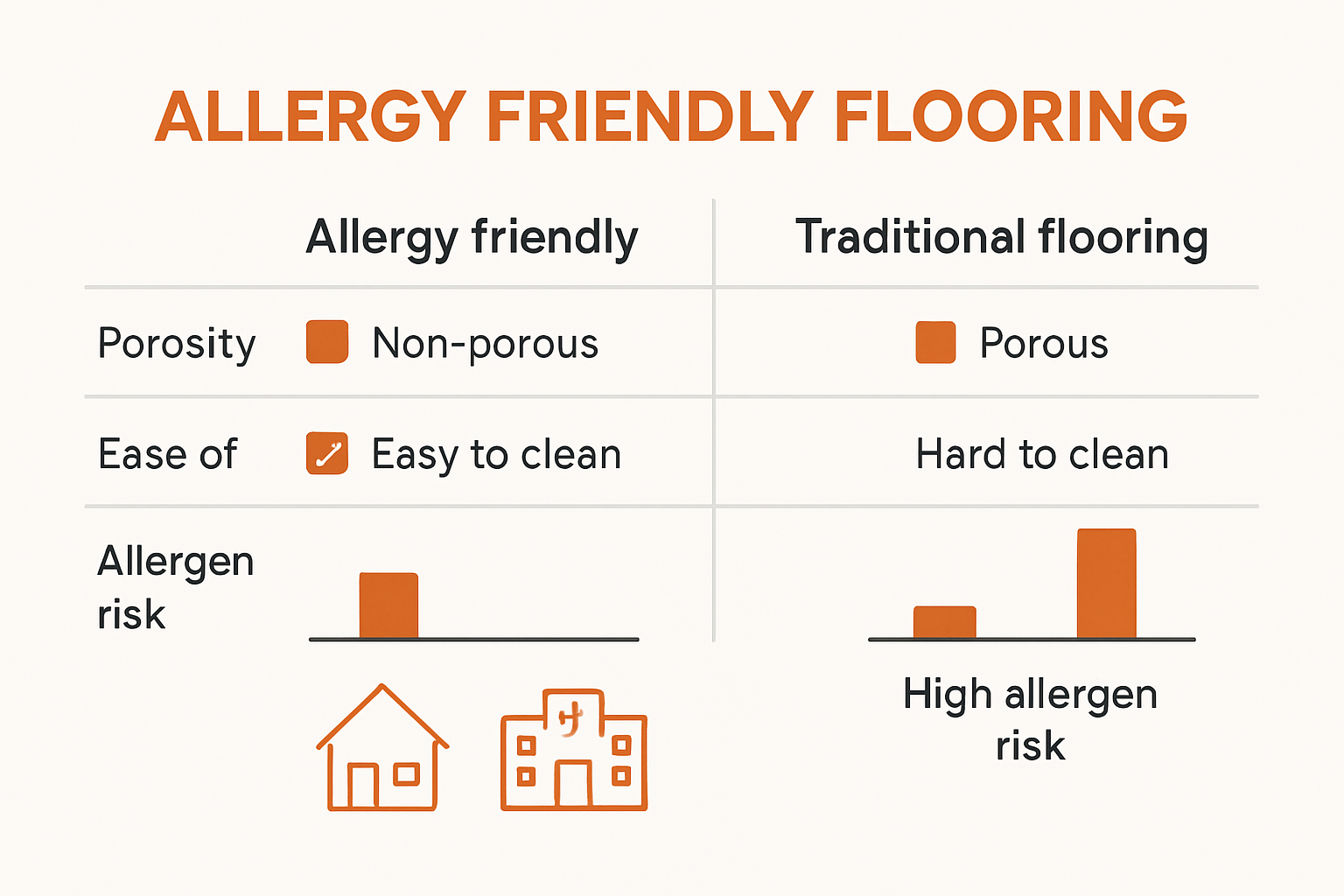Allergy friendly flooring is changing the way people think about healthy indoor spaces and it’s more than just a design choice. Most people are shocked to learn that hardwood, ceramic tile, and sealed concrete provide surfaces where dust mites and pollen almost cannot survive at all. It sounds simple, but swapping out that old carpet could mean fewer sneezes, fewer coughs, and a safer environment for those who need it most.

Table of Contents
- What Is Allergy Friendly Flooring?
- Why Allergy Friendly Flooring Matters For Health And Safety
- How Allergy Friendly Flooring Works To Reduce Allergens
- Key Materials Used In Allergy Friendly Flooring
- Real-World Applications Of Allergy Friendly Flooring
Quick Summary
| Takeaway | Explanation |
|---|---|
| Allergy friendly flooring minimises allergen accumulation | Designed to prevent dust mites, pollen, and other allergens from settling, improving indoor air quality. |
| Materials include hardwood, ceramics, and vinyl | These non-porous materials significantly reduce moisture retention, which is key to allergen prevention. |
| Smooth surfaces support easy cleaning | Allergy friendly floors allow for quick and thorough cleaning, reducing the chance of allergens remaining. |
| Protect vulnerable populations | Children, the elderly, and those with respiratory issues benefit most from allergen-resistant flooring. |
| Implement in healthcare and homes | These floors are critical in clinics and residential settings to enhance health and wellbeing. |
What is Allergy Friendly Flooring?
Allergy friendly flooring represents a specialised category of floor surfaces designed to minimise allergen accumulation, reduce respiratory irritation, and promote healthier indoor environments. These innovative flooring solutions prioritise materials and construction techniques that actively prevent dust, mites, pollen, and other microscopic particles from embedding or thriving within the floor surface.
Understanding Allergen Transmission Through Flooring
Traditional flooring materials like carpets and textured surfaces can act as significant reservoirs for allergens, trapping microscopic particles deep within their fibres and textures. According to research from the US Environmental Protection Agency, indoor environments with porous flooring can significantly contribute to poor air quality and increased allergy symptoms.
Key characteristics of allergy friendly flooring include:
- Smooth, non-porous surface texture
- Easy to clean and sanitise
- Minimal microscopic crevices or fibrous materials
- Resistance to moisture and microbial growth
Materials and Design Strategies
Allergy friendly flooring typically incorporates materials that naturally resist allergen accumulation. Hardwood, sealed concrete, ceramic tiles, and certain synthetic materials like vinyl and linoleum offer excellent allergy prevention properties. These surfaces provide a seamless barrier against dust mites, pet dander, and other respiratory irritants.
Manufacturers of allergy friendly flooring focus on creating surfaces with minimal microscopic spaces where allergens could potentially hide. By engineering flooring with tight molecular structures and smooth finishes, they effectively reduce the potential for particulate matter to become trapped and continuously circulate within indoor environments.
The strategic selection of allergy friendly flooring goes beyond aesthetic considerations, representing a proactive approach to creating healthier living and working spaces that support respiratory wellness and overall environmental hygiene.
Why Allergy Friendly Flooring Matters for Health and Safety
Allergy friendly flooring transcends aesthetic considerations, representing a critical component of environmental health management. By minimising allergen exposure, these specialised flooring solutions play a pivotal role in protecting individuals from potential respiratory complications and chronic health challenges.
Health Implications of Indoor Allergen Exposure
Indoor environments can harbour substantial concentrations of microscopic allergens that significantly impact human health. According to research published by the National Institutes of Health, prolonged exposure to indoor allergens can trigger a range of respiratory and immunological responses, including:
- Increased risk of asthma development
- Chronic respiratory inflammation
- Compromised immune system function
- Persistent allergic reactions
- Reduced overall respiratory performance
Impact on Vulnerable Populations
Certain demographic groups face heightened risks from indoor allergen exposure. Children, elderly individuals, and people with pre-existing respiratory conditions are particularly susceptible to environmental triggers. Allergy friendly flooring provides a critical protective barrier, reducing potential health risks by creating surfaces that do not harbour or accumulate microscopic irritants.

The strategic implementation of allergy friendly flooring represents more than a design choice. It is a proactive health intervention that mitigates potential long-term respiratory complications. By selecting flooring materials engineered to minimise allergen retention, individuals and organisations can create environments that support respiratory wellness, reduce chronic health risks, and promote overall environmental hygiene.
How Allergy Friendly Flooring Works to Reduce Allergens
Allergy friendly flooring employs sophisticated design and material strategies to interrupt the typical lifecycle of allergens, preventing their accumulation and proliferation within indoor environments. By understanding the complex mechanisms of allergen transmission and interaction, manufacturers have developed advanced flooring solutions that actively combat microscopic irritants.
Surface Engineering and Allergen Prevention
The fundamental principle behind allergy friendly flooring involves creating surfaces that actively resist allergen attachment and propagation. According to research published in the International Journal of Environmental Research and Public Health, smooth flooring materials significantly reduce allergenic dust retention compared to traditional carpet surfaces.
Key mechanisms of allergen reduction include:
- Minimising microscopic surface irregularities
- Creating non-porous material structures
- Implementing antimicrobial surface treatments
- Enabling rapid and thorough cleaning processes
Molecular Design and Material Selection
Advanced allergy friendly flooring integrates molecular-level design strategies that fundamentally prevent allergen embedding. Materials like sealed hardwood, ceramic tiles, and high-grade synthetic surfaces are engineered with tight molecular structures that eliminate potential microhabitats for dust mites, pollen, and other microscopic allergens.
The strategic combination of smooth surfaces, hydrophobic materials, and seamless installation techniques creates an environment where allergens cannot easily settle or reproduce. By removing the typical ecological niches that support allergen growth, these innovative flooring solutions transform indoor spaces into environments that actively resist respiratory irritants.
Key Materials Used in Allergy Friendly Flooring
Choosing the right materials is fundamental to creating effective allergy friendly flooring solutions. Different materials offer unique properties that contribute to reducing allergen accumulation and maintaining healthier indoor environments.
Non-Porous and Smooth Surface Materials
Hardwood, ceramic tiles, and sealed concrete represent premium allergy friendly flooring options. According to research published in the National Institutes of Health, these materials provide exceptional surfaces that do not retain moisture or harbour microscopic allergen populations.
Key characteristics of top allergy friendly materials include:
- Seamless surface structure
- Minimal microscopic crevices
- Easy to clean and sanitise
- Resistance to microbial growth
- Low moisture retention capabilities
Synthetic and Advanced Flooring Options
Modern synthetic materials have revolutionised allergy friendly flooring technology. Luxury vinyl tiles, linoleum, and epoxy-based flooring offer sophisticated solutions that combine allergen resistance with durability and aesthetic versatility. These engineered materials feature molecular structures designed to prevent dust mite habitation and minimise particulate matter accumulation.
Manufacturers now incorporate advanced treatments and molecular engineering techniques to enhance the allergen-resistant properties of flooring materials. By developing surfaces with tightly controlled molecular structures, they create environments that actively discourage allergen settlement and proliferation.

Real-World Applications of Allergy Friendly Flooring
Allergy friendly flooring has emerged as a critical solution across diverse settings, addressing respiratory health challenges in environments where individuals spend significant time. From healthcare facilities to residential spaces, these innovative flooring solutions provide tangible benefits for managing indoor air quality and reducing allergen exposure.
Healthcare and Clinical Environments
In medical settings, allergy friendly flooring plays a crucial role in infection control and patient safety. Hospitals, clinics, and medical laboratories require surfaces that can be thoroughly sanitised and do not harbour potentially harmful microorganisms. According to Allergy UK, specialised flooring materials with naturally anti-bacterial properties help eliminate potential sources of respiratory irritants.
Key application areas in healthcare include:
- Intensive care units
- Pediatric wards
- Immunocompromised patient areas
- Surgical preparation rooms
- Laboratory research spaces
Residential and Educational Spaces
Home and educational environments represent critical domains for implementing allergy friendly flooring. Children and individuals with respiratory sensitivities benefit significantly from surfaces that minimise allergen accumulation. Schools, nurseries, and residential spaces can dramatically improve indoor air quality by selecting appropriate flooring materials that resist dust mite proliferation and provide easy maintenance.
The strategic implementation of allergy friendly flooring transcends mere aesthetic considerations. By creating environments that actively reduce potential respiratory triggers, these innovative solutions represent a proactive approach to health management across multiple professional and personal settings.
Create an Allergy Friendly Environment with Custom Mat Solutions
If you are concerned about how flooring can impact allergies, you are not alone. Many readers of the article ‘Understanding Allergy Friendly Flooring and Its Benefits’ are searching for ways to limit allergen build-up, ease cleaning routines, and make spaces safer for everyone—especially children, the elderly, or those with respiratory sensitivities. If dust, pollen, and tiny irritants are hiding in your flooring, the right surface makes a world of difference. Our allergy friendly mats provide a crucial barrier between indoors and outdoors, actively reducing the impact of microscopic particles and supporting cleaner, healthier air.

Why wait to transform your building’s environment? Visit Mats4U to browse our range of anti-slip mats and hospital and healthcare mats that are easy to maintain and great for allergy management. Choose custom sizes or branded options and put a stop to allergen accumulation today. Make your first step toward a safer, more comfortable space now with Mats4U.
Frequently Asked Questions
What is allergy friendly flooring?
Allergy friendly flooring is a type of flooring designed to minimise the accumulation of allergens such as dust mites, pollen, and pet dander. It features smooth, non-porous surfaces that are easy to clean and maintain, promoting better indoor air quality.
Why is allergy friendly flooring important for health?
Allergy friendly flooring helps reduce exposure to indoor allergens, which can trigger respiratory issues, asthma, and other health problems. It is particularly beneficial for vulnerable populations, such as children and individuals with pre-existing respiratory conditions, by creating healthier living environments.
What materials are commonly used for allergy friendly flooring?
Common materials for allergy friendly flooring include hardwood, sealed concrete, ceramic tiles, and advanced synthetic options like luxury vinyl and linoleum. These materials are non-porous, easy to clean, and resistant to moisture, making them effective in reducing allergen accumulation.
How can allergy friendly flooring reduce allergens in indoor environments?
Allergy friendly flooring utilises design principles that minimise microscopic crevices where allergens can hide. Its smooth surfaces and molecular constructions repel dust and other allergens, making it easier to keep clean and preventing harmful particles from circulating in the air.









